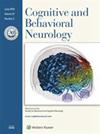谵妄是新冠肺炎的一种症状-19
IF 1.7
4区 医学
Q4 BEHAVIORAL SCIENCES
引用次数: 6
摘要
背景:谵妄是2019冠状病毒病(COVID-19)在急诊科就诊的老年人中常见的神经系统表现。目的:研究老年人中作为新冠肺炎-19症状的谵妄的临床特征,并开发逻辑回归来预测谵妄的可能性。方法:我们比较了68名年龄和性别匹配的谵妄患者和68名新冠肺炎患者(Mage=78)的临床特征。结果:谵妄组更容易出现神经、精神和心血管合并症;既往有谵妄病史;以及药物清单中的致谵妄药物。他们不太可能出现呼吸道症状,更可能出现败血症、缺氧、心率加快和钠含量升高。谵妄组的死亡率(51%)高于非谵妄组(32%)。Delium在最初的COVID-19症状出现后平均2天内出现,症状出现ED平均4天,症状出现死亡平均11天。基于五个谵妄预测因子的Logistic回归正确预测了80%的谵妄患者(75%的敏感性和86%的特异性)。结论:我们的研究结果与先前的研究基本一致,并表明谵妄是新冠肺炎-19在ED老年人中常见、早期发生和致命的表现,在大多数情况下,会导致急性或慢性神经认知功能障碍,受到炎症和缺氧-缺血机制的强烈影响。本文章由计算机程序翻译,如有差异,请以英文原文为准。
Delirium as a Presenting Symptom of COVID–19
Background: Delirium is a common neurologic manifestation of coronavirus disease 2019 (COVID–19) in older adults who present to the emergency department (ED). Objective: To investigate clinical characteristics associated with delirium as a presenting symptom of COVID–19 in older adults and develop a logistic regression to predict the likelihood of delirium. Method: We compared clinical characteristics in an age- and gender-matched sample of 68 delirious individuals with 68 nondelirious individuals (Mage = 78) who presented to the ED with COVID–19. Results: The delirious group was more likely to have neurologic, psychiatric, and cardiovascular comorbidities; a prior history of delirium; and deliriogenic medications in their medication list. They were less likely to present with respiratory symptoms and more likely to present with sepsis, hypoxia, higher heart rate, and higher sodium. The delirious group had higher mortality (51%) than the nondelirious group (32%). Delirium developed within an average of 2 days of initial COVID–19 symptom onset, with symptom onset to ED within an average of 4 days and symptom onset to death within an average of 11 days. Logistic regression based on five delirium predictors correctly predicted 80% of those with delirium (75% sensitivity at 86% specificity). Conclusion: Our results are largely consistent with prior studies and suggest that delirium is a common, early occurring, and lethal manifestation of COVID–19 in older adults presenting to the ED, in most cases causing acute on chronic neurocognitive dysfunction strongly influenced by inflammatory and hypoxic–ischemic mechanisms.
求助全文
通过发布文献求助,成功后即可免费获取论文全文。
去求助
来源期刊
CiteScore
2.40
自引率
7.10%
发文量
68
审稿时长
>12 weeks
期刊介绍:
Cognitive and Behavioral Neurology (CBN) is a forum for advances in the neurologic understanding and possible treatment of human disorders that affect thinking, learning, memory, communication, and behavior. As an incubator for innovations in these fields, CBN helps transform theory into practice. The journal serves clinical research, patient care, education, and professional advancement.
The journal welcomes contributions from neurology, cognitive neuroscience, neuropsychology, neuropsychiatry, and other relevant fields. The editors particularly encourage review articles (including reviews of clinical practice), experimental and observational case reports, instructional articles for interested students and professionals in other fields, and innovative articles that do not fit neatly into any category. Also welcome are therapeutic trials and other experimental and observational studies, brief reports, first-person accounts of neurologic experiences, position papers, hypotheses, opinion papers, commentaries, historical perspectives, and book reviews.

 求助内容:
求助内容: 应助结果提醒方式:
应助结果提醒方式:


